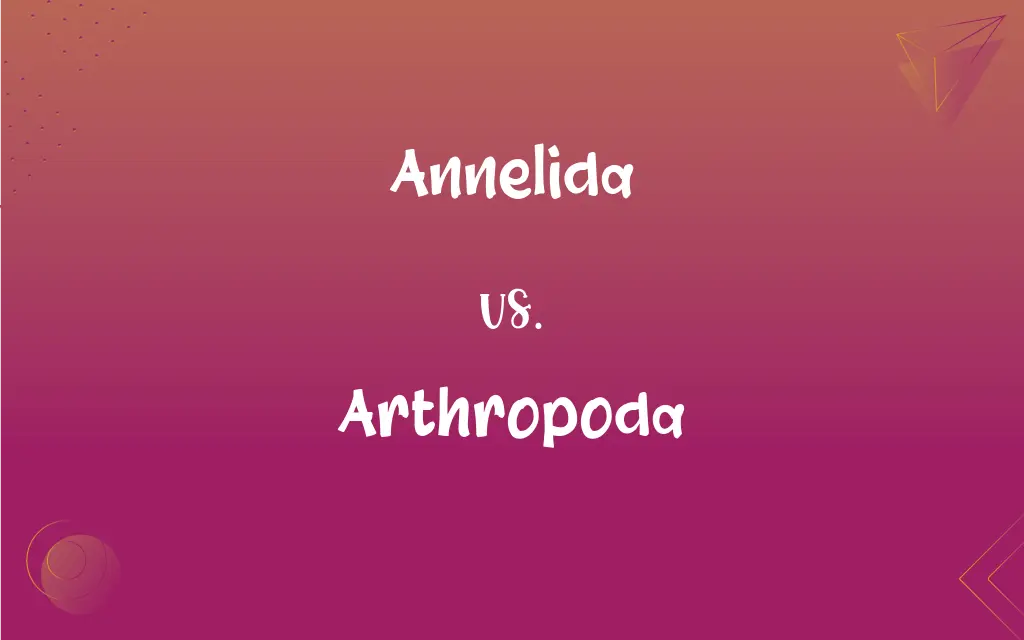Annelida vs. Arthropoda: What's the Difference?
Edited by Aimie Carlson || By Harlon Moss || Updated on October 26, 2023
Annelida are segmented worms, while Arthropoda are invertebrates with exoskeletons and jointed appendages.

Key Differences
Annelida, or segmented worms, have bodies divided into ring-like segments. Arthropoda, the largest phylum, includes creatures with exoskeletons and jointed limbs.
Annelida lack a hard exoskeleton, instead possessing a hydrostatic skeleton. Arthropoda have a chitinous exoskeleton that provides protection and support.
In terms of locomotion, Annelida move using muscles and bristles. In contrast, Arthropoda have jointed appendages enabling diverse movements.
Reproduction in Annelida often involves both sexual and asexual methods. Arthropoda primarily reproduce sexually, with complex life cycles.
Nervous systems in Annelida are simpler, with a nerve cord and ganglia. Arthropoda exhibit more advanced nervous systems, suited to their complex behaviors.
ADVERTISEMENT
Comparison Chart
Body Structure
Segmented, soft-bodied
Exoskeleton, segmented
Locomotion
Muscles and bristles
Jointed appendages
Nervous System
Simpler, with nerve cord
Advanced, with complex ganglia
Examples
Earthworms, leeches
Insects, crustaceans, arachnids
Annelida and Arthropoda Definitions
Annelida
Worms with hydrostatic skeletons.
Annelida thrive in moist environments.
ADVERTISEMENT
Arthropoda
Invertebrates with exoskeletons.
Beetles are a diverse group within Arthropoda.
Annelida
Creatures with bodies made of segments.
Annelida are crucial for ecological balance.
Arthropoda
Creatures with jointed limbs.
The Arthropoda phylum includes spiders and insects.
Annelida
Invertebrates with ringed bodies.
The garden's soil is rich in Annelida.
Arthropoda
Animals with segmented bodies.
Crustaceans are marine Arthropoda.
Annelida
Worms with a closed circulatory system.
Annelida play a vital role in soil health.
Arthropoda
Species with a chitinous exoskeleton.
Arthropoda undergo molting as they grow.
Annelida
Segmented worms.
Earthworms belong to the Annelida phylum.
Arthropoda
Largest phylum in the animal kingdom.
Arthropoda dominate many ecosystems.
Annelida
A division of the Articulata, having the body formed of numerous rings or annular segments, and without jointed legs. The principal subdivisions are the Chætopoda, including the Oligochæta or earthworms and Polychæta or marine worms; and the Hirudinea or leeches. See Chætopoda.
Arthropoda
A large division of Articulata, embracing all those that have jointed legs. It includes Insects, Arachnida, Pychnogonida, and Crustacea.
Annelida
Segmented worms: earthworms; lugworms; leeches
Arthropoda
Jointed-foot invertebrates: arachnids; crustaceans; insects; millipedes; centipedes
FAQs
What characterizes Arthropoda?
Arthropoda have exoskeletons, jointed limbs, and segmented bodies.
Do Annelida have a hard exoskeleton?
No, Annelida lack a hard exoskeleton.
How do Arthropoda move?
Arthropoda move using their jointed appendages.
Can Annelida reproduce asexually?
Yes, some Annelida can reproduce asexually.
What are Annelida?
Annelida are segmented worms like earthworms and leeches.
Do Annelida have a closed circulatory system?
Yes, Annelida have a closed circulatory system.
What are some examples of Arthropoda?
Insects, spiders, and crustaceans are examples of Arthropoda.
What habitats do Annelida occupy?
Annelida are found in various habitats, including soil and water.
Are all Arthropoda terrestrial?
No, Arthropoda inhabit terrestrial, aquatic, and aerial environments.
How do Annelida contribute to ecosystems?
Annelida improve soil fertility and structure, aiding plant growth.
What role do Arthropoda play in food chains?
Arthropoda are crucial in food chains, serving as both predators and prey.
What is the nervous system like in Arthropoda?
Arthropoda have a complex nervous system with specialized ganglia.
Are Annelida important for soil health?
Yes, Annelida like earthworms play a crucial role in soil health.
How diverse is the Arthropoda phylum?
Arthropoda is the largest and most diverse phylum.
Is the body of Annelida divided into segments?
Yes, the bodies of Annelida are divided into ring-like segments.
Are Arthropoda important for pollination?
Yes, many insects (Arthropoda) are vital pollinators for plants.
Do Arthropoda undergo metamorphosis?
Many Arthropoda undergo metamorphosis during their life cycles.
Can Annelida regenerate lost body parts?
Some Annelida can regenerate segments if they are lost.
How do Arthropoda sense their environment?
Arthropoda have specialized sensory organs for detecting stimuli.
Do Annelida have a respiratory system?
Annelida respire through their skin; some have specialized organs.
About Author
Written by
Harlon MossHarlon is a seasoned quality moderator and accomplished content writer for Difference Wiki. An alumnus of the prestigious University of California, he earned his degree in Computer Science. Leveraging his academic background, Harlon brings a meticulous and informed perspective to his work, ensuring content accuracy and excellence.
Edited by
Aimie CarlsonAimie Carlson, holding a master's degree in English literature, is a fervent English language enthusiast. She lends her writing talents to Difference Wiki, a prominent website that specializes in comparisons, offering readers insightful analyses that both captivate and inform.































































